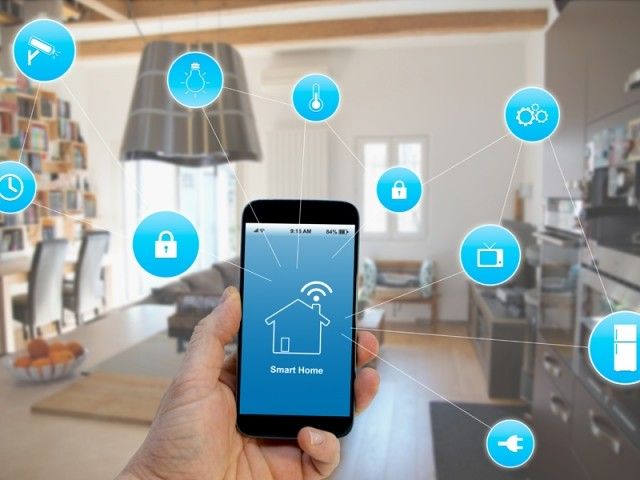
Home automation has been a part of homes and even businesses for many years now. Controlling your lights or roller shutters via your phone or by voice, creating scenarios and automations… have become common uses and accessible to all.
First compartmentalized within the systems of each brand, home automation equipment has started to interconnect in particular thanks to the platforms of Apple (HomeKit), Google (Google Home) and Amazon (Alexa).
But the REAL home automation revolution is coming thanks to the rise of Zigbee and especially Thread and Matter compatible devices. These are protocols and standards that allow unifying the different components of a connected home/business, to make them communicate and interact with each other regardless of their brand, with a minimum of hardware, software and network constraints.
To master unified and interconnected home automation, it is important to know what exactly is hidden behind these terms: this is the purpose of this article.
What is unified home automation?
You probably have connected objects at home or in your business, whether they are in the field of lighting, but also in security, heating, entertainment (music, screens, etc.), maintenance (robot vacuum cleaners, lawnmowers, etc.).
Imagine a world where all these objects could be interconnected and unified :
- whatever their type, their brand, and this without additional equipment such as bridges or bridges
- by relying on any home automation platform (Amazon Alexa, Apple Home, Google Home, Samsung SmartThings, Tuya, Home Assistant…)
- by interacting with any voice assistant (Google, Siri, Alexa …)
- in mode connected or not to the Internet

Unified and interoperable home automation is therefore this: a system where all equipment can communicate with each other, and be controlled from any platform.
New home automation protocols are revolutionizing the field and will, in the short term, make this dream possible. A real revolution because in addition to this universal interconnection, thanks to their open side we can imagine new innovative uses based on scenarios and a dose of Artificial Intelligence.
Before discussing these new usage perspectives in other blog articles, this article aims to explain to you what Zigbee, Thread and Matter are: three important and complementary components of the future unified home automation.

Zigbee: a unified home automation protocol born 20 years ago
Zigbee is a wireless communication protocol born in 2005, designed to allow small devices from various fields operating at low power (e.g. LED bulbs) to communicate with each other.
Zigbee works in a mesh network, where each device can transmit and relay data to other devices on the network. A hub or bridge is needed not only to connect this network to the Internet, but also to ensure communication between the Zigbee devices themselves within the local wireless network.


The ability of this protocol to minimize energy consumption, in particular thanks to operation at a frequency of 2.4 GHz, promotes economical use and infrequent battery changes. The open source nature of Zigbee is a key feature, allowing access and modification of the source code to adapt it to various applications.
The following diagram allows to compare the Zigbee protocol with other communication protocols (Wi-Fi, Bluetooth, etc …). We can clearly see that it is particularly suitable for home automation due to its low energy consumption (because the bandwidth and flow requirements are low), and its average range (10 – 100m).

Zigbee is very suitable for networks composed of sensors and lighting elements, heating and air conditioning control systems, video security, etc … where continuous communication is necessary without requiring high bandwidth and high power consumption.
Important point: The ZigBee protocol uses four layers out of the seven of the OSI model : from Transport to Application, we will see it in the rest of the article: this is what limits its unified and interoperable side.
Small parenthesis: here is the OSI model (from the English Open Systems Interconnection), and the different layers making up a network
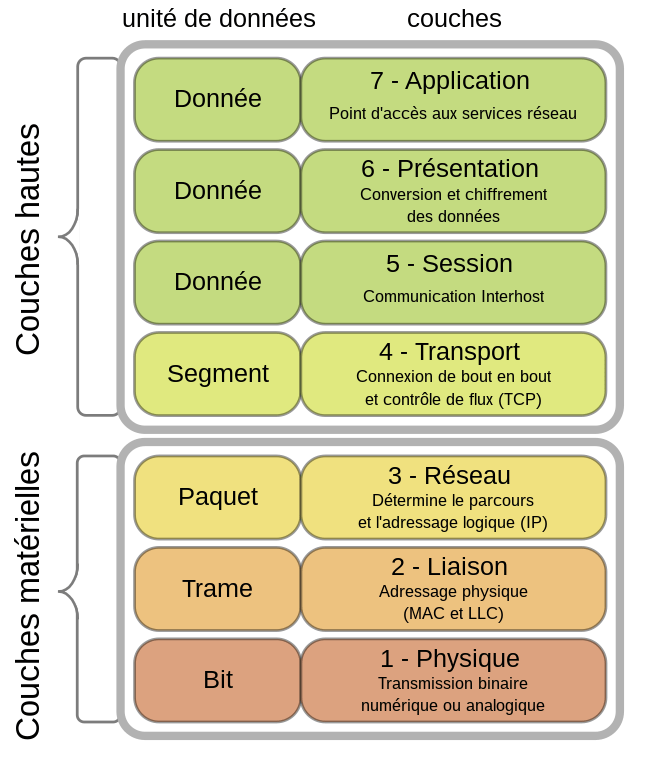
Thread: One step additional step towards interoperability
Thread is like Zigbee a communication protocol. It is designed for low-power devices in a wireless mesh network called WPAN: Wireless Personal Area Network. It is a mesh network without a bridge, that is to say without a central point: all devices are able to communicate directly with each other.

Thread is based on the TCP/IP protocol, with IPv6 addressing system. It can therefore accept thousands of addresses in a subnet, or as many different connected objects connected to each other…
Its main features are:
- Simplicity: Installation, startup and simple operations
- Security: all devices on a network Threads are authenticated and all communications are encrypted
- Reliability: Self-healing mesh networking, without bridges and therefore without a single point of failure. Extended spectrum techniques to eliminate interference
- Effectiveness: the Low-power Thread devices can run on battery power for years, and have built-in sleep features
- Scalability: Thread networks can scale to hundreds of devices
Thread is a protocol which, like Zigbee, is very suitable for networks composed of many small, low-consumption devices and exchanging information requiring low bandwidths, and where continuous communication is necessary.
Completely independent of the Wi-Fi of a home or business, it therefore allows not to overload this type of network, which remains reserved for data transfers ‘important information (Internet, Music or Video Streaming). Less energy-consuming than Wi-Fi, but as listed above, just as secure, reliable and efficient, it allows home automation uses to remain energy-efficient.
Let’s talk about the OSI model (shown above): Thread abstracts the Application layer: it is therefore (like Wi-Fi), only a communication protocol. As explained in the rest of the article, this is a crucial point in a context of unified and interconnected home automation.
To be able to have a Thread network within from your home business, it is necessary to have a Thread Border Router.
They are similar to Hubs (eg: Philips Hue Bridge, Somfy Tahoma … Zigbee Hub … ) except that they are not dedicated devices for this use, and are therefore more versatile and potentially less expensive.
Currently, we can cite the‘Apple TV 4K and Apple HomePod Miniwhich are Border Routers, as well as the latest generation Amazon Echo.
Home Assistant, the Open Source home automation application, can also act as a Thread Border Router, via the Open Thread Border Router.

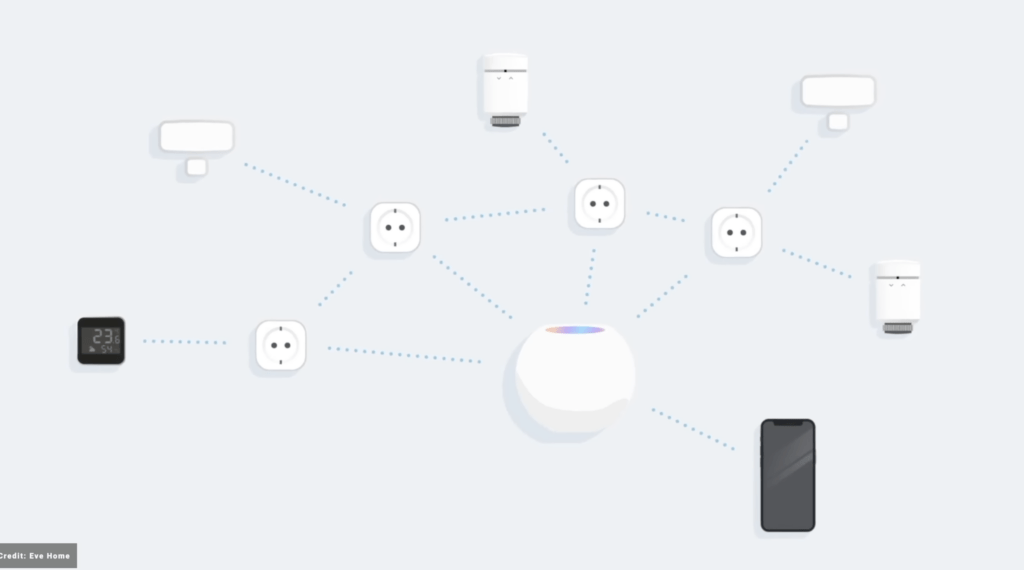
What are the differences between Thread and Zigbee?
As we have seen, Thread and Zigbee are two communication protocols suitable for home automation, due to their common characteristics, including low energy consumption.
What are the main differences between these two protocols?
The first difference between Thread and Zigbee is that the former is based on the TCP/IP protocol in IPv6, hence a huge number of interconnectable devices.
In addition, as explained previously, and as seen in the diagram below, Thread only focuses on the Network to Presentation layers (layers 4 to 6 of the OSI model), while Zigbee also encompasses the Application layer (layers 4 to 7):

As a result, Thread is more flexible than Zigbee because it can be used for any ecosystem of home automation equipment, existing or future.
Finally, even if Zigbee is a very reliable protocol, networks using it have a point of failure: the hub or gateway. This is not the case with a Thread-based network, which is meshed (without a hub) and therefore without a central point of failure. Technically: home automation devices in a Thread network communicate with each other, without a central point!
For example: if a Philips Hue Hub (using Zigbee) fails: the entire Hue network becomes non-operational
In both cases (Zigbee and Thread), within a home or business, home automation devices can work without an Internet connection, because unlike other proprietary home automation systems, there is no use of a Cloud system. There is no need for Wi-Fi because as we have seen, these are parallel networks and not dependent on Wi-Fi.
Here is a table comparing these protocols and Wi-Fi to summarize this comparison:
| Feature | Thread | Zigbee | Wi-Fi |
|---|---|---|---|
| Native IP address | Yes (Uses IPv6 for easy integration with the Internet) | No (Uses own network addresses requiring a bridge) | Yes (Universal compatibility with IP infrastructures) |
| Practical network size limit | Over 200 devices, expandable as needed | Up to 100 devices, can be expanded with repeaters | Approximately 50 devices, limited by interference and congestion |
| Equipment required | Thread Border Router: Products not specific to this use: Apple HomePod, Apple TV, Amazon Echo or more simply Home Assistant server configured for Thread (Open Thread Border Router) | Specific Zigbee hubs (100% Zigbee or with a proprietary overlay, such as for the Philips Hue or Ikea Tradfri Hubs | Wi-Fi router, Internet box |
| Typology | Mesh (Mesh) without central bridge: allows direct communication between devices. Mains-powered devices act as hubs (Device routers), battery-powered devices are termination bridges (End devices). | Mesh (Mesh) with central bridge (hub), sometimes requires routers to extend the range. | Star, depends on a central router |
| Stability | Very high with dynamic connection management | High, robust in home environments | Variable, may be affected by environmental interference |
| Security | AES-128, ECC for enhanced security | AES-128 for good basic security | AES-128/256, good security, choice depends on configured network |
Matter: a standard aimed at unifying home automation equipment
As we have seen: Thread and Zigbee are communication protocols, just like Wi-Fi or Bluetooth.
Matter was launched in 2022 by the CSA (Connectivity Standards Alliance), a consortium bringing together giants of the connected home such as Google, Samsung, Apple, Philips, and Ikea.
It is not a communication protocol, but a connectivity standard to be respected by devices compatible devices from different brands, so that they can communicate with each other. This communication is then standardized and simplified, aiming to eliminate the proprietary operations of each brand and to promote true interoperability.
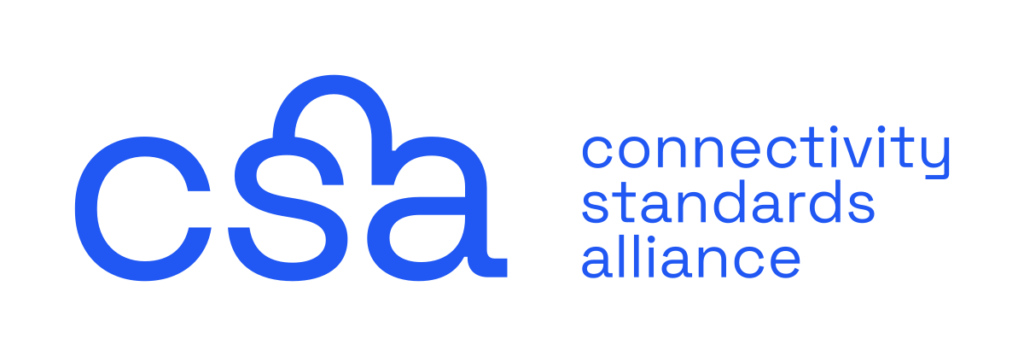
The open and Open Source nature of Matter allows its continuous improvement. Like WordPress in the web world for example, it is a whole community of developers who are responsible for improving and extending the possibilities of Matter.
Hence an extremely reliable standard that evolves quickly over time. So far, Matter releases are about two per year.
Open Source also allows customization via common or specific extensions (for the needs of a given company, for example), thus ensuring great flexibility.
A home automation network of Matter devices is particularly suited to relying on the Thread communication protocol, and therefore as we saw previously: like a mesh network without a gateway or Hub.
It can also, dynamically:
- use a Wi-Fi network: for devices requiring large data transfers, such as music and video streaming
- connect to another type of home automation network (e.g. Zigbee) via gateways
- use cellular technologies: 4G or 5G.
Matter leverages Bluetooth Low Energy (BLE) for direct communication between devices, without a central point (mesh network principle).

Matter therefore represents a major advance in the field of home automation by positioning itself as a universal connectivity standard. It allows “agnostic compatibility”: interconnection of equipment from different brands, without gateways or bridges. These devices thus united can be controlled via any compatible home automation application (Apple HomeKit, Google Home, Alexa, Tuya, Home Assistant …) as well as via all voice assistants also compatible.
For example, Google’s Nest thermostat has been updated and made Matter compatible, so it is visible in Apple’s Home app (HomeKit) … and controllable via Alexa!
They do not require any Internet connection for intra-muros operation, because no connection to any Cloud service.

We can imagine complex scenarios, created via these applications (eg: Apple’s very powerful “Shortcuts” application), as well as use in automation and workflow systems, such as Zapier or Make. As these tools can query AI tools to “augment” their processing (e.g. ChatGPT): the possibilities are endless, you just have to imagine them!
This video produced by the CSA (Connectivity Standards Alliance) illustrates the simplification and harmonization of home automation that Matter allows.
What products are Matter compatible with?
Matter initially managed seven home automation product categories: lighting, heating and ventilation, televisions, blinds, locks, security systems.
Matter 1.2 released in late 2023 enabled the integration of these types of devices: robot vacuum cleaners, connected refrigerators, dishwashers, washing machines, smoke and CO detectors, air quality sensors, air purifiers, connected fans, stand-alone air conditioners.
Since the latest version of Matter: version 1.3, released in May 2024, an energy management system for electric vehicle chargers has been introduced, offering real-time reports on parameters such as power, voltage and current. This system also allows users to schedule their car to be recharged during off-peak hours to reduce their energy bills.
In addition, Matter 1.3 expands its compatibility to several types of household appliances: microwaves, ovens, hobs, extractor hoods, tumble dryers.
In concrete terms, the preThe first products compatible with Thread / Matter were marketed from 2023, including cameras and bulbs from the Signify brand (a brand from Philips Hue), Aqara motion sensors, and connected locks from the Nuki brand.


Note that Matter can be applied retroactively to existing smart devices, by simple software update.
In summary: how ZigBee, Thread and Matter interact to serve universal home automation ?
To summarize this article, we can say that products compatible with the Matter standard allow them to operate and interact with each other regardless of their brand, using any home automation application that is also compatible.
Communication between these devices is done using the Thread communication protocol, or Zigbee (with a bridge). They can use Wi-Fi if more important data exchanges are needed than a simple switch / bulb connection. And last but not least: no Internet connection is needed for the connected objects in a home or business to work together, even if automation has been defined.
The following diagram perfectly summarizes everything that was explained in this article:

The simplest example of the power of Thread / Matter: Being able to control a bulb from brand A using a sensor from brand B, from the home automation application of brand C … Without going through a central bridge (hub), Internet, the cloud …
Connecting to the outside world via Thread Border Routers
As we have seen, Matter-compatible devices on a Thread or Zigbee network can communicate and interact with each other, thanks to Thread Border Router devices (Apple HomePod, Amazon Echo, or Home Assistant server configured as a Thread Border Router).
These devices will also allow communication with the outside world. Indeed, the Border Routers in a Thread network serve as connection bridges between the local home automation network and the Internet, allowing devices to communicate beyond the home or business environment.
Concretely, this allows you to communicate with Matter devices when you are outside the home or business.
Example: Control your fleet of lighting products in a 4G/5G network, view your cameras remotely, etc.
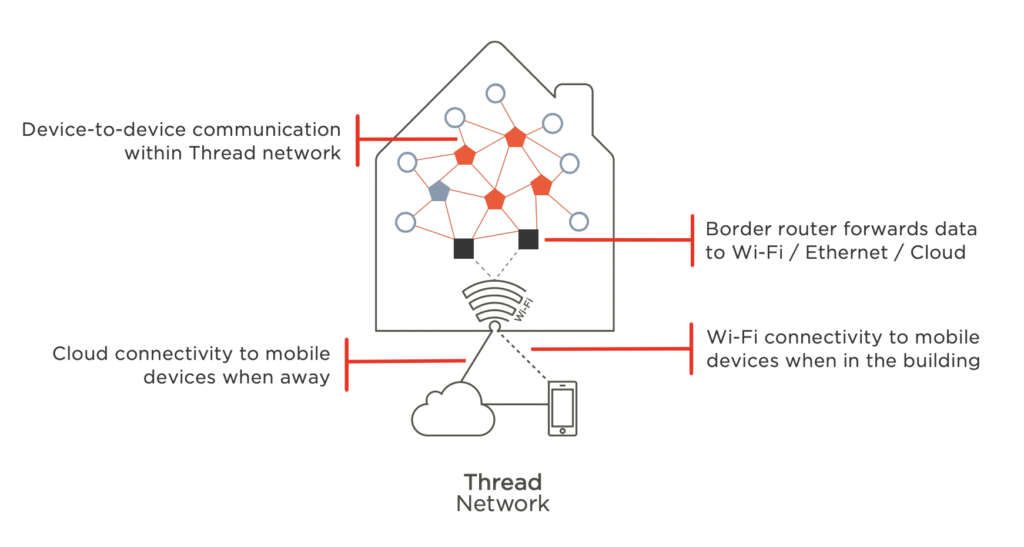
Matter / Thread: Still limited beginnings … but infinite perspectives
Although all home automation enthusiasts currently swear by the Matter protocol, it is still in its early stages and has experienced several delays. More and more compatible products are being announced, but its full deployment will take time. Currently, it is mainly lighting products, sensors, smart plugs and cameras that adopt this standard, with some devices only offering partial compatibility.
The more types of compatible products AND products marketed, the greater the possibilities for use will be whether in homes or businesses/industries.
By coupling these products with home automation applications that allow pushing automation scenarios very far (such as Apple HomeKit or Home Assistant, an Open Source home automation application), we can imagine complex and innovative scenarios that are totally crazy…
For example, with Home Assistant, a user of the French Facebook Group of the same name created an automated watering system for his garden that queries the weather service of Meteo France … We could imagine that this scenario would also involve cameras, presence sensors, lighting …

There is therefore still a long way to go before Matter becomes essential and powerful, especially since our internal tests have shown some stability issues (e.g.: Aqara door opening sensors … impossible to connect in Matter to Apple HomeKit). But when the first steps are promising, and the rate of release of new major versions is quite sustained: around 2 per year.
We will follow this closely to offer new innovative uses to our customers, in the lighting and home automation sector dedicated to businesses.

PRECISION LED has designed the PRECISION LED BOX : a fully customizable home automation box that is compatible with most connected equipment (lighting, security, openings, etc.). It is based on a Raspberry Pi and Home Assistant.
This is a completely custom-made product, which we adapt to your needs and your equipment. We also offer training so that you can become independent in the use of this equipment, which will save you a lot of time!
Do not hesitate to contact us for more information!
Any questions? Need advice? PRECISION LED is here to support you, contact us!




